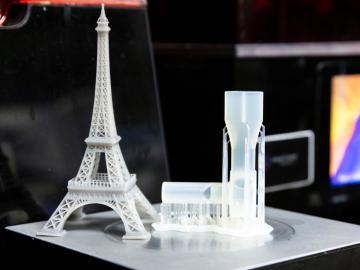Filter News
Area of Research
- (-) Biology and Environment (119)
- (-) Supercomputing (172)
- Advanced Manufacturing (7)
- Biological Systems (3)
- Biology and Soft Matter (4)
- Building Technologies (3)
- Chemical and Engineering Materials (3)
- Chemistry and Physics at Interfaces (7)
- Clean Energy (208)
- Climate and Environmental Systems (7)
- Computational Biology (1)
- Computational Chemistry (5)
- Computational Engineering (2)
- Computer Science (4)
- Data (1)
- Earth Sciences (1)
- Electricity and Smart Grid (2)
- Energy Frontier Research Centers (7)
- Energy Sciences (2)
- Fuel Cycle Science and Technology (2)
- Functional Materials for Energy (10)
- Fusion and Fission (43)
- Fusion Energy (7)
- Geographic Information Science and Technology (1)
- Isotopes (24)
- Materials (186)
- Materials Characterization (2)
- Materials for Computing (17)
- Materials Synthesis from Atoms to Systems (8)
- Materials Under Extremes (8)
- National Security (53)
- Neutron Data Analysis and Visualization (2)
- Neutron Science (83)
- Nuclear Science and Technology (35)
- Quantum Condensed Matter (3)
- Quantum information Science (5)
- Renewable Energy (2)
- Sensors and Controls (2)
- Transportation Systems (6)
News Type
News Topics
- 3-D Printing/Advanced Manufacturing (6)
- Advanced Reactors (1)
- Artificial Intelligence (27)
- Big Data (18)
- Bioenergy (30)
- Biology (49)
- Biomedical (16)
- Biotechnology (7)
- Buildings (3)
- Chemical Sciences (9)
- Clean Water (8)
- Climate Change (34)
- Composites (2)
- Computer Science (57)
- Coronavirus (11)
- Critical Materials (1)
- Cybersecurity (5)
- Decarbonization (17)
- Energy Storage (7)
- Environment (70)
- Exascale Computing (16)
- Frontier (16)
- Fusion (1)
- Grid (2)
- High-Performance Computing (34)
- Hydropower (5)
- Isotopes (2)
- Machine Learning (11)
- Materials (15)
- Materials Science (16)
- Mathematics (3)
- Mercury (6)
- Microscopy (11)
- Molten Salt (1)
- Nanotechnology (12)
- National Security (5)
- Net Zero (2)
- Neutron Science (9)
- Nuclear Energy (3)
- Partnerships (1)
- Physics (5)
- Polymers (2)
- Quantum Computing (11)
- Quantum Science (11)
- Renewable Energy (1)
- Security (2)
- Simulation (18)
- Software (1)
- Space Exploration (2)
- Summit (24)
- Sustainable Energy (20)
- Transformational Challenge Reactor (1)
- Transportation (5)
Media Contacts

The Oak Ridge Leadership Computing Facility, a Department of Energy Office of Science user facility at ORNL, is pleased to announce a new allocation program for computing time on the IBM AC922 Summit supercomputer.

The Department of Energy’s Oak Ridge National Laboratory hosted its Smoky Mountains Computational Science and Engineering Conference for the first time in person since the COVID pandemic broke in 2020. The conference, which celebrated its 20th consecutive year, took place at the Crowne Plaza Hotel in downtown Knoxville, Tenn., in late August.

From the Arctic to the Amazon, understanding the atmosphere is key to understanding our climate and other Earth systems. The ARM Data Center collects and manages global observational and experimental data amassed by the Department of Energy Office of Science’s Atmospheric Radiation Measurement user facility. For the past 30 years, it has been making this data accessible to scientists around the world who study and model the Earth’s climate.

Bob Bolton may have moved to a southerly latitude at ORNL, but he is still stewarding scientific exploration in the Arctic, along with a project that helps amplify the voices of Alaskans who reside in a landscape on the front lines of climate change.

The Exascale Small Modular Reactor effort, or ExaSMR, is a software stack developed over seven years under the Department of Energy’s Exascale Computing Project to produce the highest-resolution simulations of nuclear reactor systems to date. Now, ExaSMR has been nominated for a 2023 Gordon Bell Prize by the Association for Computing Machinery and is one of six finalists for the annual award, which honors outstanding achievements in high-performance computing from a variety of scientific domains.

Yaoping Wang, postdoctoral research associate at ORNL, has received an Early Career Award from the Asian Ecology Section, or AES, of the Ecological Society of America.

Outside the high-performance computing, or HPC, community, exascale may seem more like fodder for science fiction than a powerful tool for scientific research. Yet, when seen through the lens of real-world applications, exascale computing goes from ethereal concept to tangible reality with exceptional benefits.

Madhavi Martin brings a physicist’s tools and perspective to biological and environmental research at the Department of Energy’s Oak Ridge National Laboratory, supporting advances in bioenergy, soil carbon storage and environmental monitoring, and even helping solve a murder mystery.

Autonomous labs are changing the nature of scientific investigation. Instead of humans manually orchestrating every part of an experiment, programmed equipment can carry out necessary functions. This workflow accelerates the pace of discovery by reducing the number of monotonous tasks that researchers must perform.

Mirko Musa spent his childhood zigzagging his bike along the Po River. The Po, Italy’s longest river, cuts through a lush valley of grain and vegetable fields, which look like a green and gold ocean spreading out from the river’s banks.




